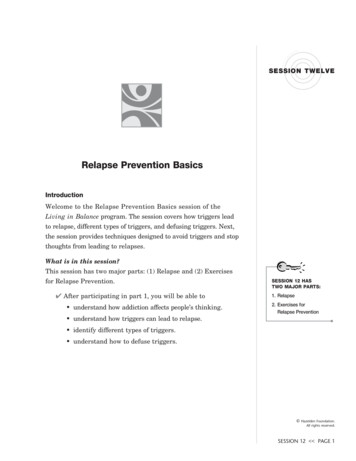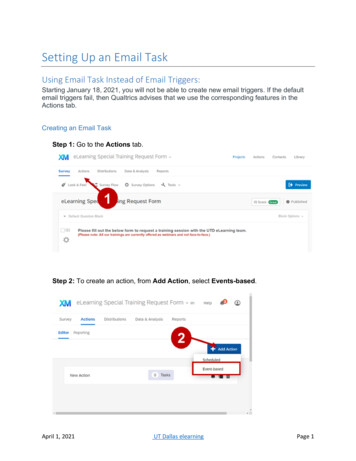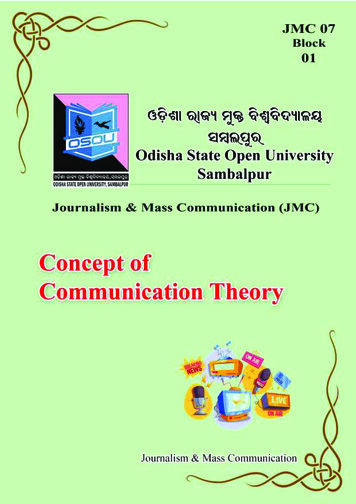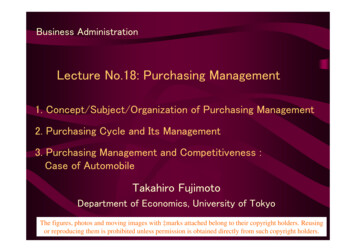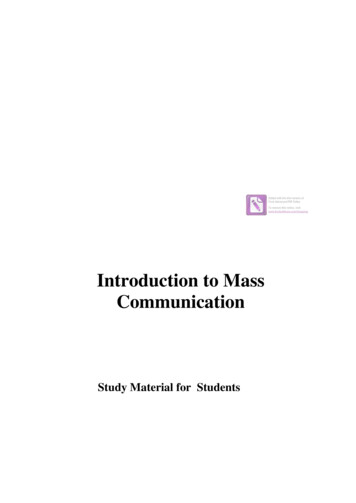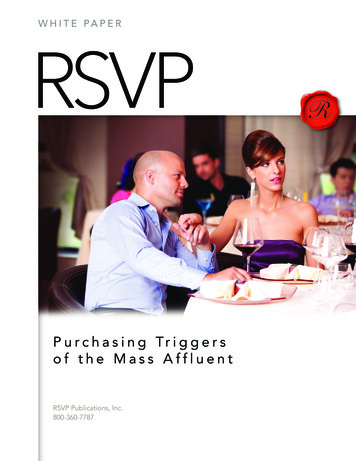
Transcription
W H I T E PA P E RP u r c h a s i n g Tr i g g e r sof the Mass AffluentRSVP Publications, Inc.800-360-77871
IntroductionThe mass affluent represent the wealthiest, most sought-afterdemographics in all of marketing. This was true when the economywas booming, but it’s even more true now as the mass affluent segmentemerges as an even more desirable target audience than ever.Begin with the fact that the majority own one and often two homes.This means they travel, buy furniture, yard and patio goods, andremodel their bathrooms and kitchens.They are also a ready audience for advertisers, who can find them attheir homes with targeted direct marketing aimed squarely at theirinterests and desires, from fine dining, entertainment and travel tocharitable giving.And of course, by definition, they have money to spend. But the affectof the Great Recession has created a different mindset regarding value,and changed their purchasing behavior.This paper cites the latest research on the mass affluent, how and wherethey spend their money, and insights into how to successfully marketand sell to this wealthy and growing segment of American society.2
Who Are The Mass Af fluent?Quite simply, the rise of the mass affluent has created a segment ofAmerican households that, for marketers, is “where the money is.”For many marketers,it makes sense toprofit from sellingto the 1 in 5, ratherthan the 4 in 5.Top21% They are the top 21% of U.S. households (1 in 5) These households (24 million households/59 million adults)are typically defined as having an annual income of 100,000 ormore. They have 60% of total U.S. income and 70% of total U.S.consumer wealth 97% are homeowners; 25% own two or more personal residences High correlation between education and affluence They are twice as likely to buy, and when they do, spend 3.2times more than the average household in many categories1Value remains a top priority and continues to be prevalent, evenamong financially successful Americans. The affluent are typicallycareful spenders that live within their means, and are knowledgeableand sophisticated consumers. Their priorities have always beenquality and value when making a purchase decision.The 2011 Affluent Survey by Ipsos Mendelsohn found that: 78% of affluents agreed, “When it comes to quality, Ibelieve you get what you pay for.”Income Tiers11% 250K 32% 150K249.9K57% 100K149.9K 60% of affluents agreed, “Even though the recession is‘officially’ over, I am still spending money much morecautiously than I used to.” Only 18% of affluents agreed, “I tend to buy based onprice, not quality.”24.5 Million Affluent Households1 Bureau of Labor Statistics - 2010 Consumer Expenditure Survey; Packaged Facts, The AffluentConsumer Market in the U.S. Dec. 20113
Who Are The Mass Af fluent?Research also found this to be true when affluent consumers areconsidering luxury purchases—for example, 89% agree, “When Idecide to purchase a luxury item, I go out of my way to find the bestprice possible.” Conversely, only 22% agreed, “If a luxury product goeson sale, it lessens the perception of luxury.”Affluents are generationally diverse2.MillenialsGen XersBoomers20%33%39%Age 18-30Age 31-47Age 48-66SeniorsAge 67 8%Affluents are strategic shoppers.Window shopping, browser, and “shopping as sport” attitudes mayall be less prevalent than a few years ago. It’s certainly clear thatmuch affluent shopping is carefully thought through and evaluated.Specifically, among affluents3:64%agree47%agree68%agree63%agree“I regularly readonline reviewsof productsbefore makingan onlinepurchase”“I regularly readonline reviewsof productsbefore making apurchase in aretail store”“When I goshoppingonline, I usuallyknow exactlywhat I want tobuy”“When I goshopping in aretail store, Iusually knowexactly what Iwant to buy”2 Mendelsohn Affluent Survey 20123 Mendelsohn Affluent Surveys 2011, HHI 100K ; American Affluence Research Center, Jan. 20124
W h a t D o T h e M a s s A f f l u e n t S p e n d O n?90% of affluent annual spending is in 10 categories: AutomotivePersonal InsuranceHome & GardenGroceriesEducation TravelApparel & AccessoriesConsumer ElectronicsLeisure & EntertainmentCharitable DonationsAffluents account forat least half to onethird of consumerspending in most ofthe sub-categories.Highlights of AFFLUENT CONSUMER spending and behavior:Automotive 2.7 vehicles owned/leased by affluents (63 million vehicles) 18% visited an auto website in the past 30 daysThe affluent account for: 36% of spending on new cars 58% of spending on motorboatsMany affluenthousehold garagescontain multiplevehicles.Home-related42% intend to “redecorate/remodel/renovate outdoors”their existing homesThe affluent account for: 70% of spending on second homes 61% of spending on kitchen appliances such as dishwashers,garbage disposals, range hoodsPersonal Insurance62% use a financial professional of some type: Broker – 26%Tax consultant – 23%Financial planner – 17%Private banker – 6%Estate planner – 3%Wealth advisor – 3%5Affluent are bigspenders on household furnishings;Home improvementprojects part ofaffluent lifestyle;Many DIYers amongaffluent consumers
W h a t D o T h e M a s s A f f l u e n t S p e n d O n?% of affluents extremely/very/somewhat interested in these financialofferings in next six months: Home/auto – 20%Financial professional – 22%Mutual fund account – 20%Credit card account – 21%Checking/savings account – 18%Brokerage/stock trading account – 17%Travel83% took a vacation/personal trip in the past yearTop U.S. cities visited: Las VegasNew York CityOrlandoLos AngelesSan Francisco 56% read travel magazines 51% visited a travel website in the past 30 days 20% viewed travel TV content in the past weekThe affluent account for: 76% of spending on cruise-ship fares 51% of spending on airline fares and trip lodgingApparelThe top methods affluents use for researching and purchasing are instore, online (via computer) and printed catalog. A growing numberare using smartphones and tablets.6Interest in newfinancial serviceofferings is high,particularly amongultra-affluents.
W h a t D o T h e M a s s A f f l u e n t S p e n d O n?Affluents spend in both mainstream and upscale retail stores,from Wal-Mart, Target, The Home Depot, Best Buy and Kohl’s toNordstrom, Banana Republic and Ralph Lauren.The affluent account for: 66% of spending on men’s suits 61% of spending on women’s suitsCharitable DonationsThe affluent account for: 68% of cash contributions to churches and religiousorganizations 59% of cash contributions to general charityEntertainment & Dining 31% said they were willing to spend more for gourmet foodThe affluent account for: 49% of spending on wine 39% of spending on dining at full-service restaurantsComputers, electronics 47% own a tablet55% own a personal SmartphoneThey spend over 37 hours a week online34% have purchased via a mobile phoneGrowth in apps for games, weather, music, social, books7Gourmet foodsattract affluent.
W h a t D o T h e M a s s A f f l u e n t S p e n d O n?The affluent account for: 59% of spending on smartphones & Pads (personal digitalassistants) 37% of spending on online gaming servicesThe affluent areheavy users ofdigital productsand early adoptersof technology.Personal Care, WellnessThe affluent account for: 32% of spending on cosmetics, perfumes and bath productsWatches & JewelryThe affluent account for: 57% of spending on watches 51% of spending on jewelryOther:High-income consumers are a crucial component of the pet market.The affluent account for: 65% on non-medical pet services61% of expenditures in veterinary service48% on pet supplies44% on pet foodAffluent women are heavy print consumers, with the highest reachand number of titles and issues read—despite their over-indexing fordigital-media devices. The affluent account for: 34% newspaper/magazine subscriptions8Print is particularlyimportant foraffluent women,and traditionalmedia remainshighly relevant intheir lives.
H o w D o Yo u G e t A f f l u e n t C o n s u m e r sTo D o B u s i n e s s w i t h Yo u ?Understanding the affluent womanMarketers should be cognizant that in the U.S., women areresponsible for an estimated 85% of consumer buying decisions.Though this figure varies by industry, women are nearly alwaysresponsible for the majority of buying decisions, even in lesstraditional categories such as banking and new cars.85%Where does your product or service stand on her prioritylist? The affluent woman has to prioritize purchases, andyou’re competing for the discretionary income that’s left aftermortgages, insurance, savings, tuition, groceries, gas, etc.Marketers need to stress the benefits that add real value to her lifeand fulfills an elevated need on her “to do” list.And that leads to another issue: the typical affluent woman is starvedfor time, and they are willing to put that discretionary income to useto try to buy it. That also means she doesn’t have time for long-windedsales pitches, long TV commercials or carefully analyzing a longmarketing message.Jeff Willard, chief marketing officer at audio-products companyHarman International, noted that luxury customers are “ininformation-search mode when they buy products today. Eventhough they’ll search for information, they don’t want to do that muchhard work. They want you to provide the information quickly.”And the affluent woman continues to be concerned about theeconomy, even as it improves. “Affluent” is not a synonym for “freespender.” She will spend if it’s important to her, but wants to be sureshe’s getting her money’s worth.9Marketers need tostress the benefitsthat add real valueto the affluentwoman.
H o w D o Yo u G e t A f f l u e n t C o n s u m e r sTo D o B u s i n e s s w i t h Yo u ?The 2012 Mendelsohn Affluent Survey noted that affluents today aremore interested in engaging the marketplace, with 65% agreeing that“sometimes I treat myself to something, even though I don’t need it”and 63% agreeing that “I still have some money left over for a littleindulgence.” This attitude trickles down into various verticals, whereaffluents are willing to spend extra for travel, gourmet food, homepurchases and brand-name goods if it means they get more comfort,service or a better product.The affluent arewilling to spendextra for travel,gourmet food,home purchasesand brand-namegoods.Value remains a top priority and continues to be prevalent, evenamong financially successful Americans. Affluents are more likelyto view themselves as middle class than as rich. They are not bashfulabout using coupons, buying store brands and going online to dopre-purchase research. They feel that they were smart in making theirmoney, and want to feel smart about how they use it. 71% of affluents use paper coupons once a month or more; 47%once a week 54% use online coupons once a month or more; 23% once aweek Coupon interest and usage show little or no drop off in moreelite financial groups ( 250K )The influence of the customer buying cycleA basic look at the buying cycle reveals three distinct stages:Awarenessawareness ofproduct or theneed they wantto fulfillConsideration Purchasethe start ofevaluatingsolutions fortheir need10Value remains atop priority amongfinancially successfulAmericans.
H o w D o Yo u G e t A f f l u e n t C o n s u m e r sTo D o B u s i n e s s w i t h Yo u ?So how do you adapt marketing to the affluent buyer’s stage in thecycle? Consumers will self-identify where they are in the buying cycleby the paths the take, provided you give them the option.Consumers who are early in the buying cycle should be provided withthe means to help them evaluate your product/service: a web page ormobile site, a brochure, educational seminar, or free on-site evaluationare traditional tools that marketers use to aid with the considerationphase. And they’re particularly appropriate for affluent consumers,who are heavy users of digital products. Integrate your trigger-specificmessaging and content into mobile or online, and move the consumerforward with another strong call to action.If a consumer still isn’t ready to buy, continue nurturing the lead bycapturing their email address and staying in touch with them throughnewsletters, blogs, webinars, success stories, and new offers. For earlystage markets where there is a lot of education required, most leads willbe very early in the buying cycle and a nurturing strategy is critical.Affluent consumer purchasing triggersConsumer purchasing triggers are events that cause a buyer to have aclear need, which usually converts into a sense of purpose and urgencyin their buying process. They fall into several categories: emotion,value, expectation, referral, recognition, reputation, familiarity, andneed.Emotion is the foremost reason we buy. Fear, passion, joy,excitement, sadness, hate, and reverence—all can lead topurchasing decisions. How often have you ended up buyingsomething impulsively or at the spur of the moment? Forinstance, fear can bring emotion to a purchasing decision—fearof gaining weight, fear of a future price increase, fear of growingold —all can lead to buying.11Integrate thoseconcepts, ideas,and words that‘click’ into thedifferent cyclesof your affluentconsumermarketing.
H o w D o Yo u G e t A f f l u e n t C o n s u m e r sTo D o B u s i n e s s w i t h Yo u ?Value is another of the strongest reasons that consumers buy.Quantity and quality can excite and incentivize consumers topurchase, with ‘buy one, get one free’ offers or markdowns onhigh-end designer good.Referral is a great contributor on buying decisions. Recognizingsomeone they know or respect has used your product or serviceand is happy with it can influence consumers. A buyer who ishappy with the outcome of the sale often can become your bestsalesman and provide you with a powerful testimonial.Expectation is another motivator that works well. Consumersbuy based on the end result of the product or service. They arepurchasing weight loss, not weight loss pills, or a romanticevening, not a dinner for two at a waterfront restaurant.Need is one of the most rudimentary buying triggers. (We go tothe supermarket whenever our need arises for groceries.)Build trigger-specific messaging and contentYour marketing should communicate your objective,whether awareness, differentiation, or improvingperception. The solution’s USP —its Unique SellingProposition—is the most crucial step in determiningyour marketing message.What problem does your product/service solve? Whatis truly unique about it (no one else has it) that is importantto selling (differentiated enough to make or break the sale) andmatters most to the consumer (can rise to their top-of-mind in theirdecision matrix)?12Most purchasedecisions are madewith fewer than sixvariables; often onesingle differentiatormakes the sale.
H o w D o Yo u G e t A f f l u e n t C o n s u m e r sTo D o B u s i n e s s w i t h Yo u ?Why should the prospect buy now? What action do you want themto take after viewing? Call, fill out a form, place an order, arrange anappointment, explore the website, etc. Give them a reason to buy now,but be aware that they may still be early in the customer buying cycleand provide them with a way to begin evaluating your product/serviceas a solution to their need.Consider what the research told us that affluent women want: moretime, value, and a quick, easy path to information and purchasing.Developing advertising that leverages affluentconsumers purchasing triggersBusy consumers decide within 2-3 seconds whether an ad is worthreviewing or passing over. The affluent are no different; they don’twant to search the ad for information or savings, so a clear and simpledesign is essential to drive response. In those seconds, the ad mustcommunicate its product or service identity, create appeal (fulfill adesire) and motivate the consumer to respond.Creative imagery, combined with a headline and worthwhile offer, arethe focus for brands that want to execute a direct mail campaign withcommerce goals.Creating headlines and copy that leverage triggersWhat are the concepts, ideas, and words that “click” in the buyer’smind? Don’t use words and concepts that have been heard a milliontimes before. Strive to be fresh, innovative, provocative and actionstirring. What is the problem that your product/service solves?Does the headline clearly identify and support the category and thebenefit to the ready? Does it create a need or desire in the mind of theconsumer?13Consumer responseis relative to an ad’sdesign, the offer‘sappeal, and theperception of value.They are mosteffective when usedtogether.
H o w D o Yo u G e t A f f l u e n t C o n s u m e r sTo D o B u s i n e s s w i t h Yo u ?The role of imagery is to help to clearly define theproduct/service category and its promise or benefitImages are the second-most important attention-getting device, afterheadline, and should support the “promise,” or benefit, of the product/service.Photos are always preferred over illustrations; people like to look atpeople. Show the consumer using the product/service; or show themenjoying its benefits, although this can be less direct. This approachrequires a focused headline to identify the product/service and createrelevancy to the image. Before and after photos are another tried-andtrue technique.Images for affluent consumer marketing should reflect their lifestyle;for example, home improvement products and services should mirrorthe quality of the homes they sell to and service. If service personnelare shown, are they professionally dressed and groomed? (Would shewant this person coming to her home?) If you’re a restaurant, show anupscale couple or group enjoying a meal or drinks, not a plate of foodin an empty room—because it’s really about enjoying a fun night out.What’s your call to action?To trigger any action online or in-store or you must have an offer, asolid call to action with a deadline. How this is structured is virtuallyunlimited.Common offers include some type of special pricing, free delivery orextra bonus item; offers can also be about the first to have somethingin a limited supply of goods. If you are offering a pricing incentive, givea reason for the special.14Full color formatsare the most effective at conveyingthe richness andexclusivity ofluxury brands.
H o w D o Yo u G e t A f f l u e n t C o n s u m e r sTo D o B u s i n e s s w i t h Yo u ?Reaching affluent consumers: multichannelmarketing that incorporates traditional mediaAffluent consumers, like others, are not just one medium; however,traditional marketing communications channels should not beforsaken, especially if marketers are targeting affluent consumers.Print marketing will likely remain a part of luxury advertisingstrategies because it is easily malleable as new technology comesout. This medium is especially effective in marketing towards babyboomers and older consumers, who are likely more able to affordluxury goods. They have grown up with and prefer print.Direct mail isresurfacing as anexclusive methodto reach affluentshoppers.On the whole, consumers appear receptive to receiving direct mail,especially if it’s personalized. It’s especially effective in reachingthe woman in the household, who is typically the one who goespurposefully through it. A USPS study of direct mail reports thatconsumers consider mail useful and are more likely to read it if ithelps them perform one of these three household job functions:browsing for new purchases, managing the home and overseeingfinances.Steve Kraus, chief research and insights officer for Ipsos MediaCT’sAudience Measurement Group, said, “Ad-receptivity measuresshow print advertising indexes really well because Affluents areconsuming it in the time and place where they are open to it.”“Direct mail is what people are comfortable with, particularlypeople who are 40 and older and who have a higher income,” he said.“These consumers were brought up with catalogs and luxury brandscan certainly show their story and imagery much better in print thanonline.15Marketers needto communicate aseamless experienceacross all channelsthat effectivelyrelays the brandimage to affluentconsumers.
H o w D o Yo u G e t A f f l u e n t C o n s u m e r sTo D o B u s i n e s s w i t h Yo u ?Direct mail pieces should be incorporated into larger multichannelapproaches and should have references that drive consumers in-storeor online to gain more informa tion and order certain products.Marketers need to communicate a seamless experience across allchannels that effectively relays the brand image—especially the highend ones.Many catalogers haven’t seen a distinct difference between their printand online buyers, because the same customers alternate betweenthe shopping channels. “Our relationship is not with the medium,but with the customer,” says Daniel Lally, director of public relationsat home goods and gifts catalog Frontgate. “The Website just givescustomers another way to do business with us.”Direct mail also helps brands to stick out from the crowdedInternet. While mail pieces can still drive purchase with promotioncodes and offers, today they can also assist in making a more directconnection through the use of digital tools. Brands can still useprint marketing and modernize it with new technology suchas QR codes, augmented reality and social media calls-toaction.Conversely, luxury brands should use other brandedplatforms to gain awareness and spread the reach of theirdirect mail efforts. For example, a brand’s Web site shouldhave an obvious link that allows readers to sign up for a catalog.“Print is always going to be a big part of marketing, “said GregFurman, CEO of the Luxury Marketing Council, New York. “It’s likewhen TV came out there was radio and people thought that therewasn’t going to be any more radio, but new media doesn’t replace theold media,” Mr. Furman said. “It just means that they have anotherchannel with which to reach and sell products to consumers.16The fewer stepsthere are for theaffluent consumerto take or get to acommerce platform,the better.
About RSVP PublicationsUpscale offers for life & homeRSVP Publications offers the ideal advertising medium for reachingaffluent consumers where they live. Targeted to the top homes ina market, RSVP reaches upscale homeowners with product andservice messages that are proven to resonate with them, such as homeimprovement, travel, dining and entertainment, professional services,and more.With a track record of over 27 years, RSVP Publications is a leading,shared mail postcard publication that reaches the top homeowners inover 80 U.S. markets. Our mailings do not target every homeowner; theyfocus on the 7 million of the most affluent ones in America, and everyhomeowner is addressed by name. Our proprietary lists, carefully chosenand screened, and continuously updated, represent the most qualifiedhomeowners.The average RSVP homeowner Is a top earner—doctor, executive, owner, high-tech professional Is highly-educated Are primarily 35 – 64 years of age Supports arts and charities Invests in the stock market Dines out often Continuously improves their home Owns two or more automobiles Travels extensively for business and pleasureAdvertisers who wish to reach this lucrative market can buy space in ourupscale postcard decks and choose which markets to distribute to. TheRSVP team can help develop a postcard that is tailored to this affluentmarket, and advise on the most effective marketing message to maximizeyour results.You can learn more about RSVP at MailToTheAffluent.comor contact us for more information:800-360-7787 rsvp@rsvppublications.com17
ResourcesIpsos Mendelsohn Affluent Survey 2012, HHI 100K Ipsos Mendelsohn February 2012 Affluent Survey updateIpsos Mendelsohn Affluent Survey 2011 Annual ReportPackaged Facts estimates based on Bureau of Labor StatisticsConsumer Expenditure Survey dataBureau of Labor Statistics Consumer Expenditure Survey dataAmerican Affluence Research Center Spring 2012 Affluent MarketTracking StudyMarketing to Women by Marti Barletta, January 2006Luxury Marketing Outlook 2012, LuxuryDaily.comeMarketer Jan 2012 Affluents: Demographic Profile and MarketingApproachesTNS study The Power of Direct Mail 200718
The mass affluent represent the wealthiest, most sought-after demographics in all of marketing. This was true when the economy was booming, but it’s even more true now as the mass affluent segment emerges as an even more desirable target audience than ever. Begin wit
